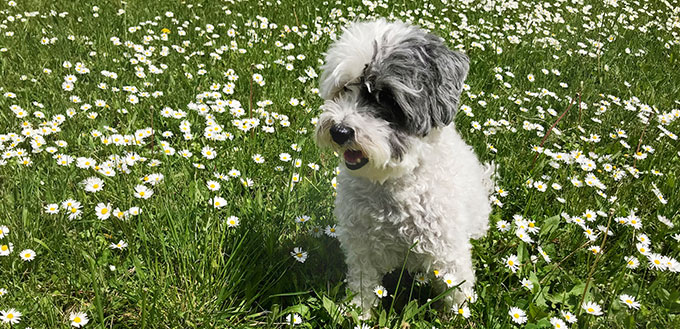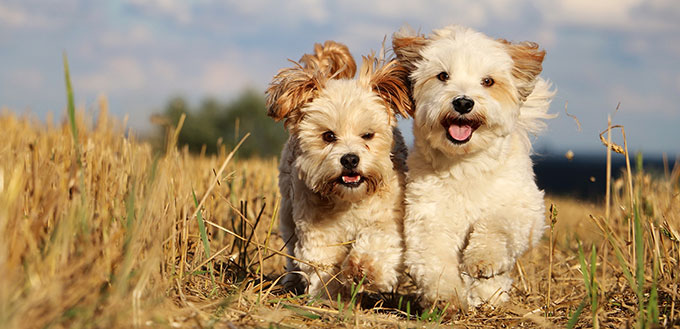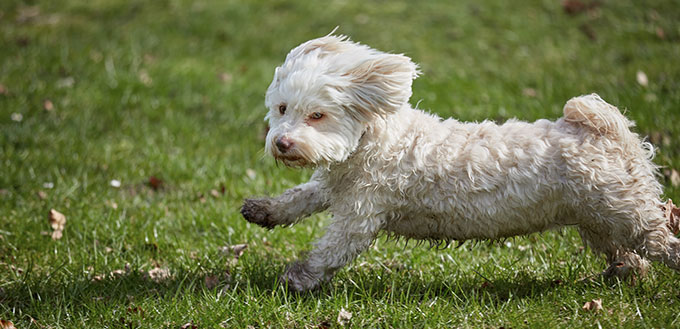With expressive eyes and cuddly nature, Havanese dogs are some of the most popular canine companions across the world. For those thinking about adding a new family member to the crew, then you would do well to consider Havanese puppies. However, with all the love in the world, it is still possible that your family may not be right for the dog. If you’re considering the Havanese dog breed, this article will tell you everything you need to know before you make the big choice and bring a Havanese puppy home.

History of the Havenese Dog
Very little is known about the initial origins of the Havanese dog, but there are some theories around their home and bloodline that may explain where the Havanese comes from. There are some who argue that Havanese are mentioned in the writings of Aristotle, due to his descriptions of the dogs at the time, or feel that Havanese puppies were bred in Malta due to historical evidence of similar dogs being found in these areas.
However, the general consensus is that the Havanese were bred from Bichon breeds, and these dogs were originally found in Tenerife. Here, there is some evidence of dogs being brought to the Americas and the Caribbean, from ship manifests at the time of their introduction to this part of the world.
They also made their way across the world to France, where their fur was trimmed to a similar standard as the poodle. They also made their way to England, where owners enjoyed leaving them with their natural fur, often referring to them as the “White Havanese” despite the various shades of fawn colors and even the black and white Havanese are known to have existed at this point.
They soon became the preferred dog of the Spanish colonists who were then based in Cuba. Particularly within the aristocracy, as they were bred to be exceptionally loyal lap dogs who would never leave their owners’ side. Thus, they then became known as a “Velcro dog” due to their unwavering loyalty and commitment to their owners.
This also explains why the Havanese dog breed is so tolerant to heat, given that they have silk-like fur, which is light and fine enough to allow for rapid cooling and insulation against the summer sun. This fur is now one of the most important parts of the breed classification, in which the American Kennel Club (AKC) will check if the dog matches the breed standards in order to compete as a pedigree.
During the Cuban revolution, the upper classes quickly fled the country, finding their way to American where the Havanese can now be commonly found. In 1996, the Havanese breed was officially recognized by the AKC and the pedigree has now become one of the fastest growing breeds in the US.
There is now a further sub-categorized breed of the Havanese dog, called the Havana Silk Dog. This breed is derived entirely from breeders in Havana following years of pressure from the AKC and similar and is not currently recognized by the AKC as a pedigree breed. The Havana Silk Dog Association has not filed for recognition from the AKC, either. These dogs have taller front legs, which are straighter, as well as smaller ears and a longer snout.
Quick Facts
Interested in knowing a few quick facts about the Havanese dog breed? These Havanese dog breeds facts are fantastic if you’re looking to learn the basics about this dog, or if you simply want to update your quiz knowledge!
- The havanese dog breed is also known as the Havanese terrier, Havanese Cuban Bichon, Bichón Havanés, Havaneser, Havanezer, Havanese Silk Dogs and Bichon Habanero.
- They come with a range of AKC-accepted coat colorings, such as black and white Havanese dogs through to simple white Havanese or fawn colored coats.
- They are known as a “Velcro dog” due to their unwavering loyalty to their masters
- They hail from Tenerife and are thought to be a cross between the Bichon and Poodle.
- Are classed as a “toy” breed by the AKC.
- They are highly resistant to hot weather but do not do as well in the cold.
- Havanese dogs typically have a lifespan of between 14 and 16 years.
- They are frequently used as therapy dogs, as well as being used as assistance dogs or even signal dogs, due to their gentle, loving nature and trainability.
- They require considerable grooming.
- The Havanese dog breed enjoys between 20 – 40 minutes of exercise per day.
- This breed makes for an excellent family dog.
- The breed organization responsible for overseeing breeding standards is the Havanese Club of America.
- Easily suits both apartment living and being in a larger house.
- Very intelligent and easy to train.
- They typically grow up to around 28cm in height and can weigh up to 7kg.

Things You Should Know
Now you know the basics of the Havanese dog breed and how they came to be so popular across the world, it’s time to take a look as to whether this is the best dog breed for you. Check out our guide below, to see if a Havanese puppy will be a fantastic canine companion in your life.
Training
Havanese dogs are very easy to train, which is mostly due to their desire to please their master. They are very loyal and therefore will often strive to work with you when training, making it much easier to pick up the basics. They are also very intelligent dogs who enjoy lots of games and mental stimulation, and training is a fantastic way to keep your Havanese puppies happy as they turn into a full grown Havanese.
For those interested, the Havanese dog breed is able to easily pick up much more complex training and work, thanks to their intelligence and trainability. In fact, many breeds go on to work as companion or service dogs in many industries, as well as being known to take part in dog competitions such as flyball or obedience.
Feeding
As with all new dogs, Havanese puppies will need to remain on the food which the breeder had been using, prior to your adoption or purchase. They will need to stay on this for at least 6 months, to allow them to grow strong and healthy during this phase of their life. They may also require good quality rawhide while teething to help them with the pain and frustration that comes with growing a new set of teeth!
Puppies should be free-fed, in that they are able to access their food at any time of day. Once the puppy is between 4 and 6 months old, you may be able to begin putting the food down at specific times, providing they are still reacting well to any changes.
A full grown Havanese can be placed on adult dog food but we recommend picking out a specialized diet that is suited for a Havanese adult dog. For both puppies and adults, how much you feed your Havanese is dependent on the food you buy, its caloric density and nutritive value, and how active or lethargic your particular dog is.
Always monitor your Havanese weight gain or loss when feeding, since your Havanese dogs’ size will indicate whether they are eating too much or too little, as well as keeping an eye on their stools. When you get to know your dog, you’ll soon know when to make the necessary adjustments too. For example, if you notice some signs of constipation, add a little water to their kibble to increase the moisture content, which should get things going again.
Grooming
Havanese dogs will require regular grooming – especially if you’re keen to keep them with a longer coat. They will often need to be brushed at least twice a week in order to maintain their best coat, stop them from shedding and ensuring that their fur does not become matted or tangle. They are also known for growing longer hair between the pads of their paws, which can sometimes become matted, pick up dirt and debris when on walks or simply decrease the level of traction they can gain on the floor.
Thus, if you aren’t interested in showing your dog at competitions, then it may be easier for you to get them professionally groomed regularly, whereby the fur can be trimmed down to make it easier for owners to work with. Doing this will also mean that you may be able to remove tear-staining, which is common in the Havanese dog breed.
Due to their background and fine hair, they can become cold very easily. So, if you’re heading out in the colder climate, don’t be afraid to use dog coats and dog boots to protect your pup from becoming ill during weather.
Health
Generally speaking, the Havanese dog breed is a healthy specimen which is unlikely to suffer from many health problems, as long as they are bred by a responsible breeder. There are, however, a few illnesses which they are more likely to develop than some other dog breeds, including chondrodysplasia, hip dysplasia, Legg Perthes or Patellar Luxation.
These illnesses are all related to the musculoskeletal system, resulting in problems with the bones coming out of place or skeletal development. The likelihood of these illnesses can be significantly reduced by following an appropriate diet that is filled with all the vitamins and minerals required, as well as keeping an eye on your Havanese weight gain or loss.
This breed is also prone to deafness, although responsible breeders should conduct hearing tests of both the parents and the offspring before placing Havanese puppies with their new family. Similarly, liver shunts – another health problem in the Havanese dog breed – will show signs of this illness before six months of age, as this is a genetic condition, and should therefore be stemmed by breeders before your purchase.
As always, the best way to keep on top of the health of your Havanese dog is to ensure that they receive their full list of vaccinations. They should also have a health check-up every six months, and any symptoms such as loss of appetite of lethargy should be reported to your vet, as soon as possible.

Temperament
The Havanese temperament is a great source of joy to dog owners. Their unconditional love and complete loyalty to their favorite humans is unwavering, although they are still generally friendly and open to strangers. The Havanese dog breed tends to enjoy being around humans more than other dogs, but they are not known to be particularly aggressive or domineering to other pups.
This breed requires lots of socialization, both to enjoy the company of others without becoming fearful or aggressive and because they do not do well on their own for long periods of time. Thus, this is not a dog that would suit a busy household that spends a lot of time at work or outside. Doing so will cause separation anxiety, which will cause your dog to become destructive. They would much prefer to be by your side all day, which is where they got their nickname as a “Velcro dog”.
Like most dogs, the Havanese do require a good amount of exercise and stimulation, or else they can become bored. When bored, they will often bark excessively, chew and become visibly distressed when they are not adequately physically and mentally stimulated. However, their exercise needs are suitable for families, where they can receive shorter walks and plenty of playtime. Most Havanese dogs will be perfectly happy to take a short walk for around half an hour and spend some time playing in the back yard.
The biggest benefit to owning a Havanese dog breed is having a friend for life, and most of the positives around having this breed in your house is their eagerness to please and be by your side. As such, you should only ever purchase a Havanese dog if you are sure they will not be left alone for long periods of time and you have the energy required for lots of playtime! If so, you will find a friend for life in the Havanese dog.







